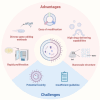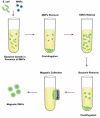Opportunities and challenges of bacterial extracellular vesicles in regenerative medicine
- PMID: 39754127
- PMCID: PMC11697683
- DOI: 10.1186/s12951-024-02935-1
Opportunities and challenges of bacterial extracellular vesicles in regenerative medicine
Abstract
Extracellular vesicles (EVs) are membrane-bound vesicles that are shed or secreted from the cell membrane and enveloped by a lipid bilayer. They possess stability, low immunogenicity, and non-cytotoxicity, exhibiting extensive prospects in regenerative medicine (RM). However, natural EVs pose challenges, such as insufficient targeting capabilities, potential biosafety concerns, and limited acquisition pathways. Although engineered EVs demonstrate excellent therapeutic efficacy, challenges such as low production yield and the complexity of engineering modifications constrain their further clinical applications. Bacteria have advantages such as rapid proliferation, diverse gene editing methods, mature cultivation techniques, and relatively easy preparation of bacterial EVs (BEVs), which can be used to effectively address the challenges currently encountered in the field of EVs. This review provides a description of the biogenesis and pathophysiological functions of BEVs, and strategies for optimizing BEVs preparation to attain efficiency and safety are discussed. An analysis of natural characteristics of BEVs is also conducted to explore how to leverage their advantages or mitigate their limitations, thereby overcoming constraints on the application of BEVs in RM. In summary, engineered BEVs possess characteristics such as high production yield, excellent stability, and high drug-delivering capabilities, laying the foundation for their application in RM.
Keywords: Bacterial extracellular vesicles; Drug delivery; Engineering strategy; Outer membrane vesicles; Regenerative medicine.
© 2025. The Author(s).
Conflict of interest statement
Declarations. Ethics approval and consent to participate: Not applicable. Consent for publication: Not applicable. Competing interests: The authors declare no competing interests.
Figures








References
-
- van Niel G, D’Angelo G, Raposo G. Shedding light on the cell biology of extracellular vesicles. Nat Rev Mol Cell Biol. 2018;19(4):213–28. - PubMed
-
- Huang J, Wang X, Wang Z, Deng L, Wang Y, Tang Y, Luo L, Leung EL. Extracellular vesicles as a novel mediator of interkingdom communication. Cytokine Growth Factor Rev. 2023;73:173. - PubMed
-
- Cheng L, Hill AF. Therapeutically harnessing extracellular vesicles. Nat Rev Drug Discov. 2022;21(5):379–99. - PubMed
-
- Valadi H, Ekström K, Bossios A, Sjöstrand M, Lee JJ, Lötvall JO. Exosome-mediated transfer of mRNAs and microRNAs is a novel mechanism of genetic exchange between cells. Nat Cell Biol. 2007;9(6):654–9. - PubMed
-
- Bjørge IM, Kim SY, Mano JF, Kalionis B, Chrzanowski W. Extracellular vesicles, exosomes and shedding vesicles in regenerative medicine—a new paradigm for tissue repair. Biomater Sci. 2017;6(1):60–78. - PubMed
Publication types
MeSH terms
Grants and funding
- 201802020018/Science and Technology Project of Guangzhou City
- 2019A1515010408/Guangdong Science and Technology Program
- NTP202304/Clinical New Technology Project of Southern Medical University Stomatological Hospital
- 2023ZDZX2009/Key Project of Guangdong Province General Higher Education in Key Areas
- PY2022015/Science research cultivation program of stomatological hospitalSouthern medical university
LinkOut - more resources
Full Text Sources

